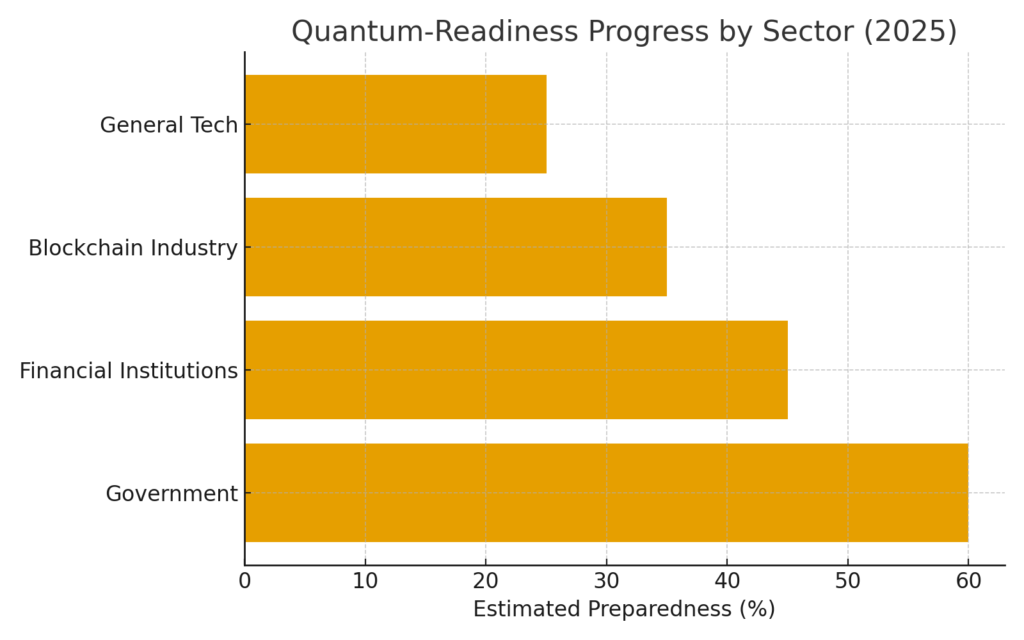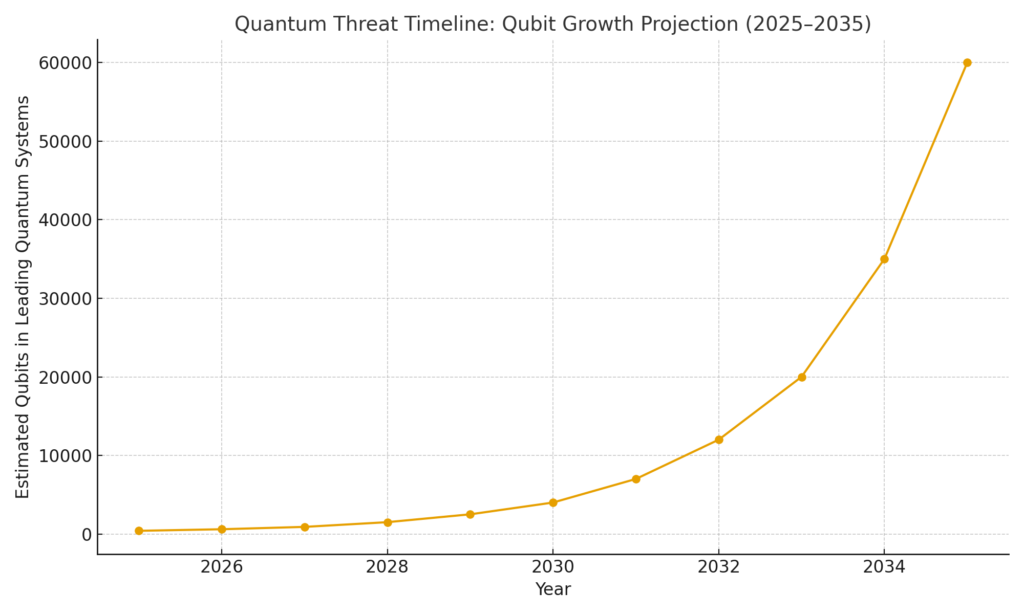
Main Points :
- Quantum computing is still in its early phase, yet experts believe it will pose a realistic threat to Bitcoin and other Proof-of-Work blockchains within the next 10 years.
- The underlying cryptographic algorithms—especially elliptic-curve digital signature schemes—are vulnerable to a sufficiently powerful quantum adversary.
- Institutions (e.g., BlackRock) have already flagged quantum computing as a risk in filings, signalling market awareness.
- Some blockchains and cryptography specialists are developing post-quantum (quantum-resistant) frameworks, but many of these do not yet cover legacy Bitcoin address formats.
- For crypto-investors and blockchain practitioners seeking new assets or innovations, quantum-resistance introduces both a risk and an opportunity: risk for unsecured assets, opportunity for platforms offering next-generation quantum-safe features.
1. The Early Stage of Quantum Threat, Yet the Clock Is Ticking
In a recent interview, Amit Mehra of venture-capital firm Borderless Capital stated that quantum computing remains in its “dawn period”, but that the technology will soon pose a credible threat to Bitcoin and other PoW systems. He cautioned that people tend to under-estimate the pace of innovation in semiconductor, computing and distributed-computing fields.
This view is consistent with independent research: while large-scale cryptographically-relevant quantum computers (CRQCs) are not here yet, expert analyses suggest they may arrive within a decade or less.
From an investor or blockchain-practitioner standpoint, this means the “quantum clock” is already ticking—even if the threat is not immediate.
2. Why Bitcoin’s Cryptography Is Vulnerable
2.1 Elliptic-Curve Signatures (ECDSA / Schnorr)
Bitcoin’s security model relies on elliptic-curve digital signature algorithms (ECDSA and more recently Schnorr) to prove ownership of coins. Cryptographic literature confirms that these signature schemes are not quantum-resistant and therefore vulnerable if a sufficiently large and error-corrected quantum computer becomes available.
2.2 The Address Format Problem
One key vulnerability arises not in all cases but specifically for Bitcoin addresses where the public key has already been revealed on-chain (e.g., P2PK or reused P2PKH). Once the public key is visible, a quantum adversary could, in theory, derive the private key and drain the funds.
2.3 “Harvest-Now, Decrypt-Later” Threat
A further complication: adversaries may collect encrypted data today (for example transaction history or keys tied to visible addresses) and wait until quantum computers are capable of decrypting or deriving private keys. This “harvest now, decrypt later” model amplifies urgency.
2.4 Hashing & Proof-of-Work Considerations
While the proof-of-work (SHA-256) and related mining components are less clearly at immediate risk (due to how quantum speed-up applies), the signature layer remains the prime concern.
3. Institutional Awareness and Market Signals
Major financial institutions are taking note. For example, BlackRock’s update of its iShares Bitcoin Trust (IBIT) filing specifically cited quantum computing as a risk factor that “could potentially undermine the viability of many of the cryptographic algorithms used across … digital assets like bitcoin.”
Further, industry gatherings and closed-door lunches (e.g., one cited by Fred Krueger) have discussed a likely future solution for Bitcoin: a hard fork to implement quantum-resistance.
For crypto-asset allocators and platform builders, these are meaningful signals: the risk is being tracked at the institutional level, and the ecosystem may need to respond proactively.
4. Quantum-Resistant Developments: Where We Stand
4.1 Blockchain Projects with Quantum-Safe Focus
Some blockchain platforms are already building with quantum-resistance in mind, such as Quantum Resistant Ledger (QRL), which uses post-quantum algorithms (e.g., XMSS) to protect against quantum attacks.
Other projects (such as SUI) have announced frameworks that aim to protect blockchains without requiring address resets or hard forks, though they may not cover older networks like Bitcoin or Ethereum.
4.2 Standardisation Efforts
The National Institute of Standards and Technology (NIST) has been working since 2017 on standardising post-quantum cryptography (PQC). Some PQC algorithms were selected in 2024-25 for standardisation, underscoring a global move toward quantum-safe encryption.
4.3 Bitcoin’s Path Forward
In Bitcoin’s case, upgrading to quantum-resistant signature schemes is technically complex due to decentralisation and backward-compatibility concerns. Some researchers estimate more than 70 days of downtime may be required for a full transition.
Nevertheless, technical literature suggests Bitcoin will eventually evolve to meet the quantum threat.

5. Implications for Crypto-Assets, New Projects & Blockchain Practitioners

5.1 Risk for Legacy Coins & Inactive Addresses
From an asset-holder’s perspective, coins held in older addresses where the public key is exposed (or reused) are particularly vulnerable. One estimate suggests around 25–30% of Bitcoin supply may already sit in vulnerable formats.
Thus, those seeking to hold Bitcoin long-term may want to ensure funds are moved to quantum-resistant or at least newer address types and private keys stored with quantum threat awareness.
5.2 Opportunity in Quantum-Resistant Platforms
From a blockchain innovation standpoint, projects that embed quantum-resilience from day one may gain competitive differentiation. This can appeal to institutionals, VASPs, wallets and custody services advertising “post-quantum safe” features.
5.3 Timing & Transition Strategy
Given the threat horizon (estimated 5-10 years in many reports) and the time required for network upgrade, prudent actors (developers, auditors, VASPs) should start planning now. For example, wallet providers building non-custodial services should integrate post-quantum key management options or migration paths.
5.4 Relevance for Your Audience
Since you are interested in new crypto assets, income opportunities, and practical blockchain applications, this trend is directly relevant:
- You might evaluate assets that prioritise quantum-resistance and highlight this as part of marketing or technical white-paper narratives.
- For wallet development or custody (including your non-custodial wallet project ‘dzilla Wallet’), quantum-safe architecture can become a value proposition.
- For VASP/EMI auditing frameworks, quantum-risk might become part of the technology risk landscape (i.e., “Are you prepared for post-quantum cryptography migration?”).
6. Proposed Graph/Diagram

7. Conclusion
In conclusion, while the quantum-computing threat to Bitcoin is not immediate, it is increasingly realistic and actionable within a 5-to-10-year horizon. The cryptographic foundations of Bitcoin are well-studied and documented to be vulnerable to a future quantum adversary; institutional investors and crypto platforms are taking note. For those in the blockchain industry—including developers building wallets, VASPs offering services, or investors evaluating new crypto-assets—the “quantum dimension” is no longer academic. It represents both a risk for legacy assets and a strategic opportunity for projects that adopt quantum-resilient architecture. Proactive planning, migration strategy, and architectural design for post-quantum resilience should be embedded now. The countdown to “Q-Day” may be underway.

